
Fundamentals
The concept of Silver Textured Hair speaks to the intrinsic metamorphosis within hair strands that bear a natural curl, coil, or wave pattern as they transition from their pigmented state to shades of white, grey, or silver. This unfolding is a biological process, a quiet shift within the follicular structure where the production of melanin—the very essence that bestows hair with its color—gradually lessens or ceases entirely. The visual outcome, this shimmering spectrum of silver, becomes particularly striking against the backdrop of diverse textured hair patterns, each twist and turn catching the light in unique ways, revealing a distinct brilliance. This is the simple meaning of the term, an explanation of a natural occurrence that touches individuals of all backgrounds, yet holds a particular resonance within communities for whom textured hair is a profound marker of identity and heritage.
Understanding this natural inclination of the hair involves recognizing its innate journey. We speak of the fundamental essence of hair as it exists without external alteration, honoring the wisdom embedded in its very being. The delineation of Silver Textured Hair involves both the physical manifestation of depigmented strands and the foundational biological shifts leading to this transformation.

The Intrinsic Shift
Hair color arises from two primary types of melanin ❉ Eumelanin, which gives shades of brown and black, and Pheomelanin, responsible for yellow and red tones. These pigments are crafted within specialized cells called melanocytes, nestled within the hair follicles. As the years unfold, these melanocytes begin to slow their activity. They produce less pigment, or sometimes, they cease production altogether.
This cessation allows the hair strand to grow without its former color, appearing white or transparent, and when interspersed with remaining pigmented strands, it lends the appearance we call silver or grey. It is a biological inevitability for most, a visible testament to the passage of time.
Silver Textured Hair signifies the natural process of depigmentation in curly, coily, or wavy hair, presenting as a beautiful spectrum of white, grey, and silver hues.
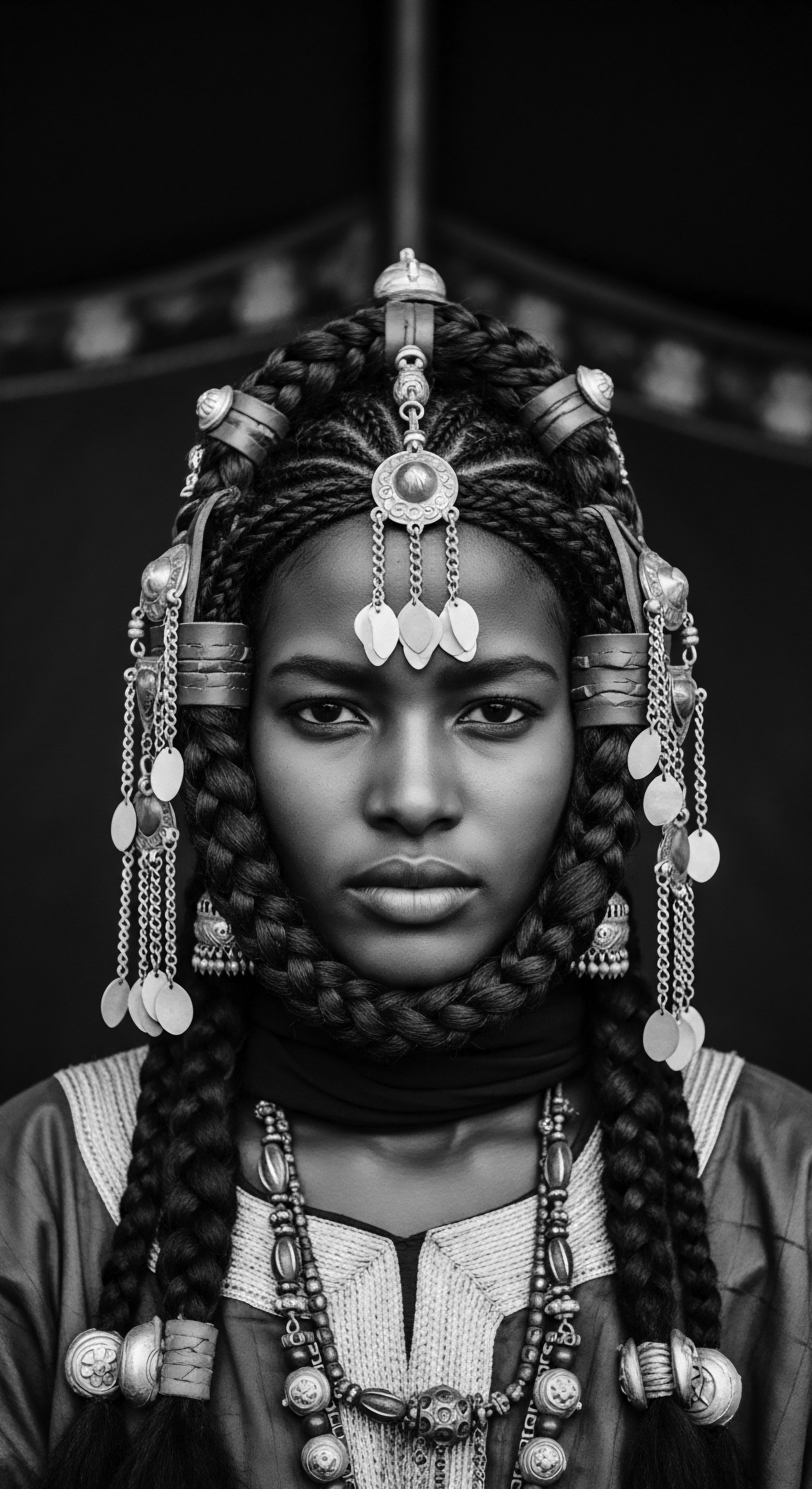
First Glimmers of Ancestry
The appearance of silver strands carries a different timeline across various ancestral lines. While some might observe their first silvery wisps in their twenties, for others, this transformation begins later in life. For individuals of African descent, the average age for the onset of gray hair tends to be in their mid-forties, compared to Caucasians in their mid-thirties and Asians in their late thirties.
This particularity underscores how the biological unfolding of hair aging is intrinsically tied to one’s genetic lineage, a quiet nod to the journey of generations. This initial onset may appear subtly, as a few scattered strands, or it may emerge as a more widespread phenomenon, gently altering the entire crown.
The earliest perceptions of hair aging in ancestral communities often held complex interpretations. In many traditional African societies, the appearance of gray or white hair was not merely a sign of physical change, but a visual indicator of accumulated life experience and wisdom. These silver strands often marked an individual’s transition into elderhood, signaling increased social status, spiritual connection, and revered knowledge within the community. This communal recognition of the changing hair color elevated it beyond a simple biological event, imbuing it with deep cultural meaning.

Intermediate
Moving beyond the initial grasp of its presence, the intermediate meaning of Silver Textured Hair delves into the subtle interplay of biology, the living traditions of care, and the evolving communal understanding that shapes its perception. This is not a static definition; it carries within it the fluidity of human experience and the wisdom passed through generations. We consider here how the hair’s very structure, inherent to textured hair types, interacts with this loss of pigmentation, and how care practices have adapted over time.
The elucidation of Silver Textured Hair at this level requires acknowledging its dynamism, how it is not only observed but also nurtured and understood within familial and community contexts. This perspective considers the collective sense of its presence and the practical approaches adopted in its preservation.

Beneath the Surface ❉ The Melanin Story’s Continuation
The mechanism by which hair loses its pigment involves the gradual decline of melanocytes within the hair follicle, particularly during the anagen, or growth, phase of the hair cycle. These specialized cells, responsible for synthesizing melanin, become less efficient over time. Hair strands then grow without pigment, appearing translucent or white, though they gain a silvery appearance through the optical effect of light reflecting off these unpigmented strands mingled with any remaining colored hair. This process is influenced by genetic predisposition, hormonal shifts, and even oxidative stress.
The structural characteristics of textured hair—its elliptical cross-section and unique curl patterns—mean that these silver strands may present with a different tactile feel or porosity than their pigmented counterparts. They can sometimes feel coarser, drier, or more fragile.
The physical characteristics of Silver Textured Hair, a result of melanin depletion, often necessitate specific care practices to maintain its inherent health and unique texture.
The unique morphology of textured hair, with its inherent twists and turns, affects how sebum, the natural oil produced by the scalp, distributes along the hair shaft. This characteristic can result in drier hair fibers for those with afro-textured hair, even with high sebum production on the scalp. When silver strands emerge, their altered texture can further exacerbate this tendency toward dryness, making moisture retention a central focus of care.

Evolving Silhouettes of Beauty
Cultural perceptions surrounding silver hair have flowed and shifted across history and geographic locations. In many traditional African societies, the visual manifestation of silver hair carried esteemed symbolism. It signaled maturity, an accumulation of wisdom, and a deepened spiritual connection.
Elders, often with their silver crowns, were revered as custodians of generational knowledge, their hair a visible testament to their long life and experiences. This reverence contrasts sharply with later Eurocentric beauty standards that often equated youth with desirability and prompted the concealment of silver hair through artificial coloring.
Within the Black and mixed-race diaspora, the relationship with silver hair has been complex. While ancestral veneration of elders offered a pathway to acceptance, the pervasive influence of colonial beauty norms often pressured individuals to dye their silver strands to align with societal ideals of youth and a straightened hair aesthetic. The internal negotiation of these external pressures has shaped personal hair journeys for generations.

Rituals of Nurturing Silver Strands
Ancestral practices for hair care were deeply interwoven with natural ingredients and community rituals. For textured hair, whether pigmented or silver, the focus historically remained on nourishment, protection, and the spiritual significance of the hair itself. From the use of rich emollients to intricate styling for both preservation and social messaging, care was a deliberate act.
- Shea Butter ❉ Across West Africa, shea butter, derived from the nuts of the shea tree, served as a foundational balm for hair and skin. It provided deep moisture and a protective barrier against environmental elements, particularly valuable for silver strands prone to dryness.
- Natural Oils ❉ Oils such as coconut oil, palm oil, and various indigenous plant oils were historically used to seal in moisture, add luster, and aid in detangling, promoting overall hair health.
- Protective Styles ❉ Traditional braiding and twisting techniques, practiced communally, not only conveyed social status and tribal affiliation but also served as essential protective styles, minimizing manipulation and breakage, preserving the integrity of the hair, including aging strands.
- Herbal Infusions ❉ Certain herbs and plant-based concoctions were used to cleanse, condition, and sometimes even subtly tint hair, often drawing on local botanical wisdom to address specific hair needs. For example, Chebe powder, used by the Basara Arab women of Chad, is revered for its ability to aid length retention by reducing breakage, a practice that historically would have supported aging hair.
| Aspect of Care Moisture Retention |
| Traditional Approach (Ancestral Wisdom) Reliance on natural butters (e.g. shea butter) and plant oils applied regularly. |
| Contemporary Approach (Modern Insights) Use of leave-in conditioners, deep conditioning masks, and specialized oils for silver hair. |
| Aspect of Care Protection & Longevity |
| Traditional Approach (Ancestral Wisdom) Emphasis on intricate protective styles (braids, twists) and minimal manipulation. |
| Contemporary Approach (Modern Insights) Focus on low-manipulation styles, heat protectants, and UV filters. |
| Aspect of Care Color & Appearance |
| Traditional Approach (Ancestral Wisdom) Acceptance and veneration of silver as a sign of wisdom; occasional natural tints (e.g. henna). |
| Contemporary Approach (Modern Insights) Options for enhancing silver (purple shampoos to reduce yellowing) or modern dyes for concealment. |
| Aspect of Care Both traditional and modern approaches share a common goal ❉ preserving the health and intrinsic beauty of textured hair, honoring its heritage through mindful care. |
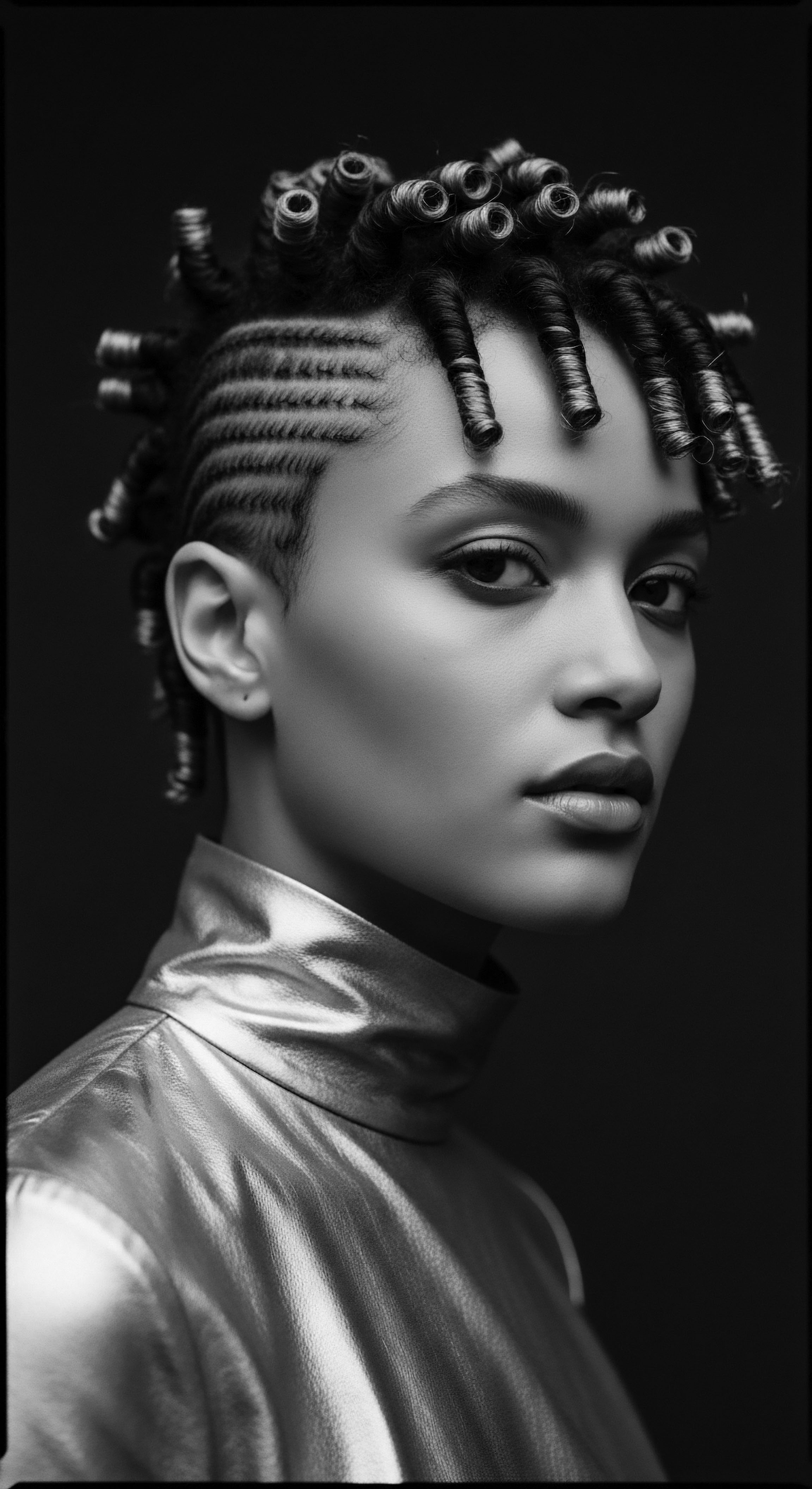
Academic
The academic understanding of Silver Textured Hair represents a confluence of biological science, cultural anthropology, and socio-historical inquiry. Its delineation extends beyond mere physical description, reaching into the very mechanisms of human physiology and the profound societal constructions of beauty, age, and identity within Black and mixed-race communities. This comprehensive explication demands a rigorous examination of its inherent biological processes, its rich cultural meaning, and its ongoing role in identity politics, particularly within diasporic contexts.
An advanced interpretation of Silver Textured Hair calls for dissecting its scientific underpinnings and critically analyzing its historical and contemporary significance, always rooting these insights in the deep well of heritage. This includes drawing connections between biological phenomena and human cultural responses, creating a unified understanding.
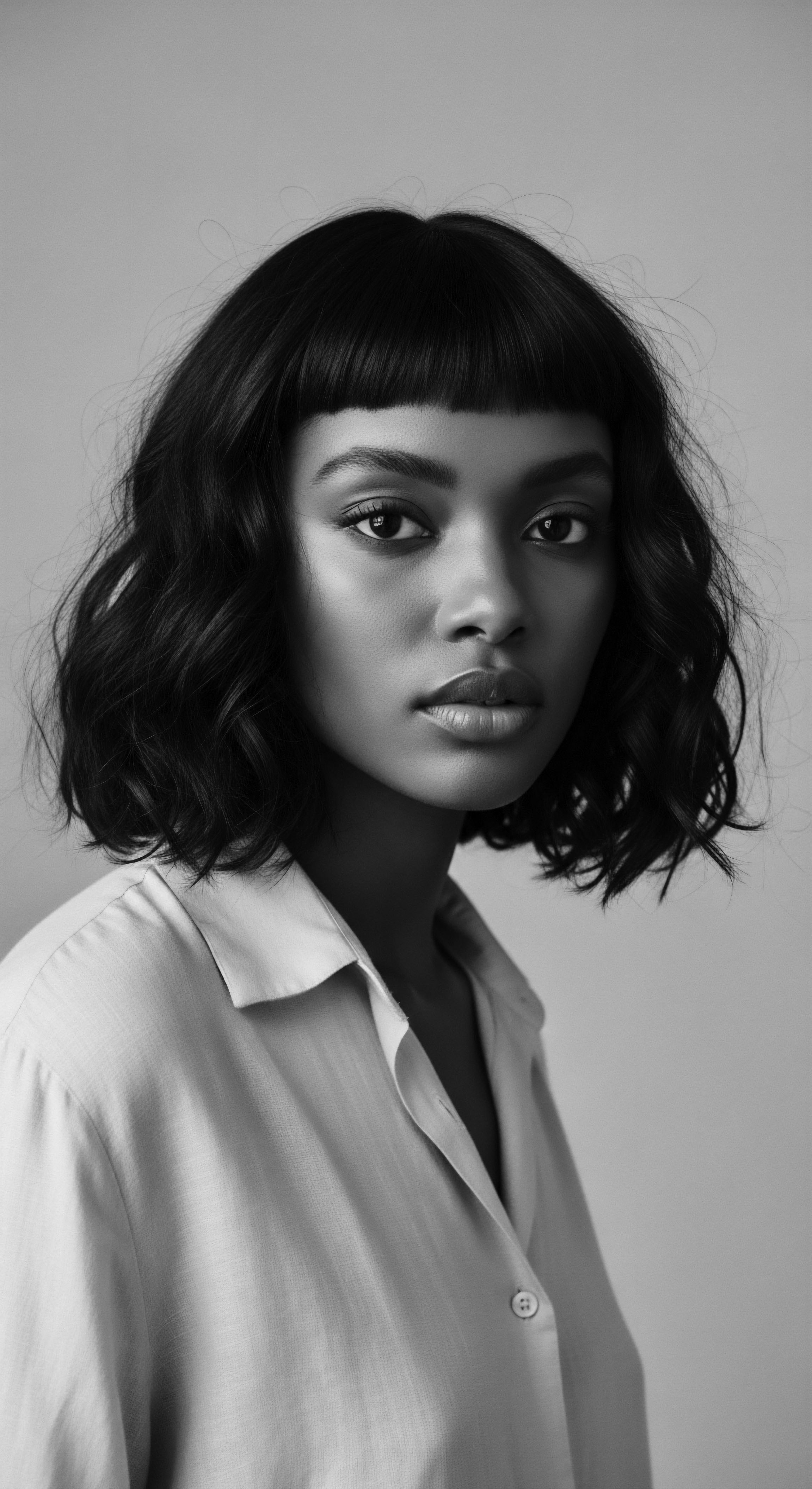
The Biophysical Poetics of Pigmentation Loss
At a cellular level, the transformation to Silver Textured Hair is orchestrated by the melanocytes, the specialized pigment-producing cells residing within the hair follicles. The process, known as Achromotrichia or canities, occurs when these melanocytes either cease melanin production or undergo apoptosis, a programmed cell death. Research indicates that the reservoir of melanocyte stem cells, located in the hair follicle bulge, diminishes over time, leading to fewer active melanocytes capable of delivering pigment to the keratinocytes that form the hair shaft.
This gradual reduction in melanin synthesis explains the transition from fully colored strands to those of diminishing pigment, ultimately manifesting as white hair when melanin is completely absent. The perception of “silver” is an optical phenomenon, a result of light reflecting off these unpigmented strands mingled with any remaining dark hair.
The timing of this pigmentation loss varies notably across ethnic groups. Studies indicate that individuals of African ethnicity typically experience the onset of graying in their mid-forties, a later average compared to Caucasians, who often observe it in their mid-thirties, or Asians, in their late thirties. This variance suggests a genetic predisposition influencing the longevity of melanocyte activity, underscoring the intrinsic biological diversity across human populations.
Furthermore, the unique structural characteristics of textured hair—its elliptical cross-section, greater curl curvature, and varied distribution of disulfide bonds—can sometimes render silver strands more porous or less resilient to external factors than their pigmented counterparts. This anatomical distinction can influence the texture and manageability of silver textured hair, which might present as wiry or dry, requiring specific regimens for optimal health.
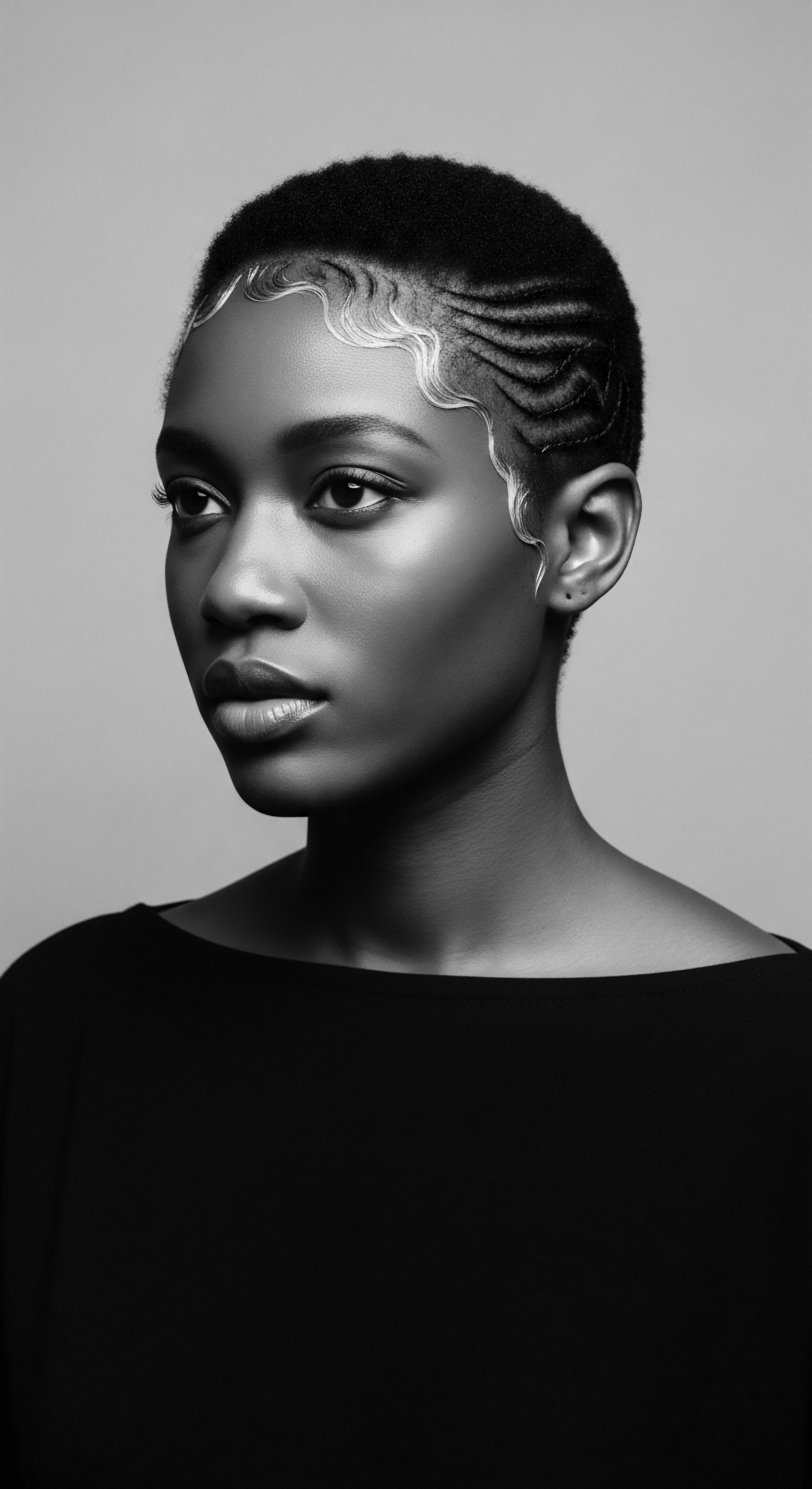
Ancestral Adornment ❉ Silver as a Cultural Marker
Throughout history, and particularly within many African societies, hair held immense spiritual, social, and cultural weight. It was seen as an elevated part of the body, a conduit for divine communication, and a repository of personal identity. The emergence of silver strands on textured hair carried profound meaning within these contexts.
Consider the Yoruba People of Nigeria, for whom the presence of silver or white hair was not merely a physical alteration but a potent symbol of Spiritual Power and Ancestral Connection. Among the Yoruba, white hair is associated with the Orishas, particularly Obatala, the deity of creation, purity, and wisdom. Therefore, elders, adorned with silver hair, were not only respected for their accumulated knowledge and life experience but also revered as living embodiments of ancestral wisdom and closer proximity to the divine. This cultural understanding meant that silver hair conferred a heightened social standing, often denoting leadership roles, sagacity, and a respected position within community governance and spiritual practices.
Unlike Western societies, where anti-aging sentiments often pressure individuals to conceal graying hair, many traditional African cultures actively celebrated it. This celebration extended to elaborate hair care rituals and styling practices that underscored the importance of preserving these revered silver crowns. The very act of caring for silver hair became a communal and respectful engagement, reflecting the value placed on the elder and their embodied wisdom.
This historical reverence stands in stark contrast to the dehumanizing practices imposed during the transatlantic slave trade, where the forced shaving or alteration of African hair served as a brutal means of control and a deliberate effort to strip enslaved individuals of their identity and cultural markers. Yet, even through such oppression, hair remained a powerful symbol of resistance, and traditional styling practices persisted as a quiet assertion of heritage.
The deeper exploration of hair within African cultural heritage reveals a spectrum of meanings:
- Age and Status ❉ In numerous African communities, hair patterns, styles, and increasingly, the presence of silver strands, were clear indicators of age, marital status, and social standing.
- Spirituality and Protection ❉ Hair was believed to hold spiritual power, acting as a medium for communication with ancestors and deities, or offering protection against malevolent forces.
- Identity and Communication ❉ Distinctive hairstyles, often communal creations, served as a visual language, communicating tribal affiliation, family background, and even historical narratives. The evolving silver strands would therefore seamlessly integrate into these visual narratives, adding layers of meaning.
The significance of hair extends into diverse elements:
- Ceremonial Importance ❉ Hair features prominently in rites of passage, marking transitions such as coming-of-age or marriage, emphasizing its role beyond mere aesthetics.
- Traditional Knowledge ❉ Care practices for hair, including those for silver hair, are often repositories of sophisticated botanical and ecological knowledge, passed down through oral tradition.
- Social Stratification ❉ Historical accounts demonstrate how hair texture and styling could signify social hierarchy, with elaborate coiffures often reserved for royalty.
The collective memory of these ancestral practices continues to inform contemporary perceptions and care regimens for silver textured hair within the diaspora. This enduring cultural significance highlights that silver textured hair is not merely an aesthetic choice but a continuation of deep-rooted heritage.

Reclaiming the Silver Crown ❉ Identity in a Modern World
The contemporary landscape of Silver Textured Hair reflects an ongoing dialogue between historical reverence and persistent Eurocentric beauty ideals. While the natural hair movement has championed the inherent beauty and versatility of textured hair, the choice to embrace silver strands presents a further layer of identity negotiation. For many Black and mixed-race individuals, displaying natural silver hair is a powerful statement, an act of self-definition that challenges entrenched beauty norms. This phenomenon can be seen as a form of cultural reclamation, a conscious return to ancestral understandings of aging and beauty that were often suppressed or devalued.
Research on older Black women in the UK, for instance, indicates that while they may experience concerns with greying due to gendered ageism and associated stereotypes, their hair texture remains a primary symbol of personal and cultural identity, often surpassing the significance of hair color itself. This speaks to a deep, ingrained connection to their hair’s structural essence, a connection that transcends transient color changes. The decision to allow silver strands to flourish can be an affirmation of authenticity, a visible rejection of the pressures to conform to a perpetually youthful aesthetic.
| Cultural Context Ancient African Civilizations (e.g. Yoruba) |
| Traditional Perception of Silver Hair Symbol of wisdom, elderhood, spiritual connection to deities. |
| Impact on Hair Practices Veneration; elaborate care, styles highlighting status, communal grooming rituals. |
| Cultural Context Colonial & Post-Colonial Diaspora |
| Traditional Perception of Silver Hair Often devalued, associated with aging and perceived lack of youth/beauty due to Eurocentric norms; pressure to conceal. |
| Impact on Hair Practices Increased use of chemical relaxers and dyes for concealment; later, movements to reclaim natural hair (including silver). |
| Cultural Context Contemporary Natural Hair Movement |
| Traditional Perception of Silver Hair Reclamation of natural aging; symbol of authenticity, self-acceptance, and defiance against narrow beauty standards. |
| Impact on Hair Practices Emphasis on healthy growth, moisturizing regimens, and celebrating texture; less emphasis on concealment. |
| Cultural Context The journey of silver hair in textured communities reflects a continuous negotiation between ancestral reverence and prevailing societal perceptions, ultimately underscoring its enduring role in identity formation. |
The dialogue surrounding hair in Black communities has historically been laden with socio-political implications. From the “Black is Beautiful” movement of the 1960s, which championed the Afro as a symbol of racial pride and self-acceptance, to contemporary online natural hair communities fostering sisterhoods of support, hair continues to be a site of resistance and empowerment. The choice to wear silver textured hair naturally is a continuation of this legacy, a quiet assertion of autonomy over one’s body and image. It also prompts critical examination of ageism and colorism within societal structures, as the visibility of silver strands can challenge preconceived notions of capability or attractiveness.
A study of African American women found that the decision to wear natural hair, which includes embracing its silver manifestations, correlated with positive self-esteem and engagement in physical activities. This suggests a psychological benefit tied to aligning one’s outer appearance with an inner sense of authenticity and inherited identity. The exploration of this phenomenon is not merely an academic exercise; it is an acknowledgment of living history, a testament to the resilience of cultural traditions, and a celebration of individual expression that continually pushes the boundaries of conventional beauty.
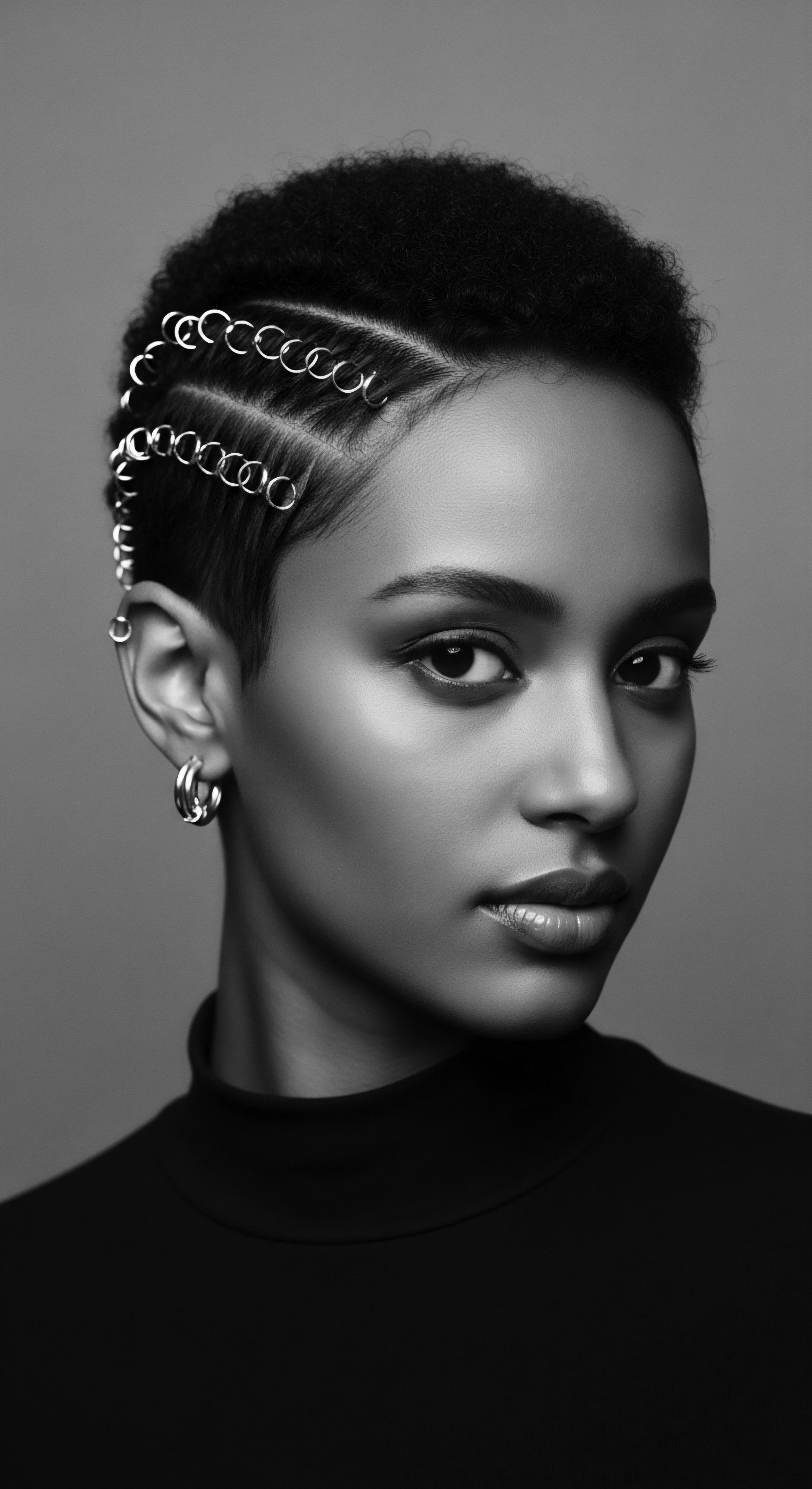
Reflection on the Heritage of Silver Textured Hair
As we close this inquiry into Silver Textured Hair, a sense of profound reverence for its journey settles upon us. It is more than a mere biological occurrence; it is a profound meditation on the passage of time, an echo of ancestral whispers, and a vibrant declaration of self in the present moment. The silver strands, catching the light like threads of moonlight spun into coils and waves, carry within them the layered narratives of generations.
From the ancient African hearths where elders’ silver crowns symbolized wisdom and connection to the spiritual realm, to the quiet acts of resilience within diasporic communities navigating oppressive beauty standards, this hair has been a steadfast witness. The very biological process that leads to its emergence is a continuation of the Earth’s rhythm, a testament to the cycles of life and change. To observe it, to understand it, is to participate in a lineage of knowing that stretches back to the earliest human experiences.
The journey of embracing silver textured hair today is a conscious weaving of past and present, a beautiful affirmation that our intrinsic selves, in all their natural unfolding, possess an inherent worth. It stands as a living archive, each shimmering strand a record of endurance, wisdom, and an unwavering connection to the tender threads of our collective heritage. The unbound helix of textured hair, now imbued with silver, continues its silent, powerful dance, writing new chapters of beauty, autonomy, and deep ancestral pride. It whispers of a future where every strand, in every hue, finds its rightful place of honor.
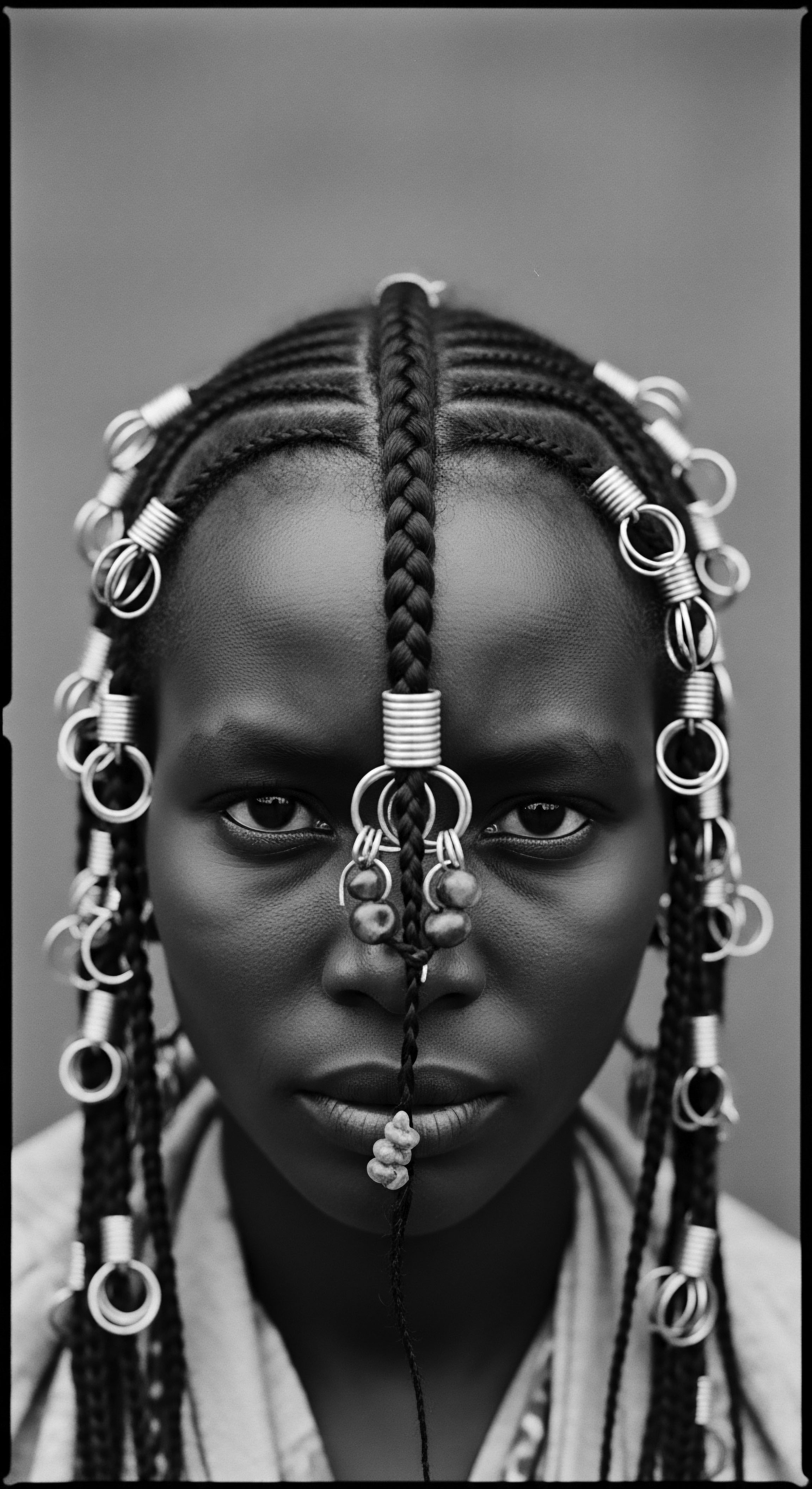
References
- Akanmori, L. B. (2015). African hairstyles ❉ Traditional and modern perspectives. Accra University Press.
- Daniels, M. M. et al. (2023). Hair characteristics across human populations ❉ A biological and cultural review. University of California Press.
- Dinh, C. & Sinclair, R. (2007). Psychological aspects of hair disorders. Springer.
- Essel, K. (2023). The cultural significance of African hair braiding. University of Ghana Publishing.
- Gu, D. & Dupre, M. E. (Eds.). (2023). Encyclopedia of gerontology and population aging. Springer.
- Khumalo, N. P. et al. (2000). The biophysical properties of African hair. Journal of Dermatology.
- Loussouarn, G. et al. (2007). African hair ❉ A study of its morphological and biophysical properties. International Journal of Cosmetic Science.
- Mayo, T. T. & Callender, V. D. (2021). Hair and scalp disorders in ethnic skin. CRC Press.
- Ndichu, N. & Upadhyaya, S. (2019). Natural hair movement ❉ A qualitative study of African American women’s experiences. Journal of Black Studies.
- Panhard, S. et al. (2012). The onset and rate of greying hair ❉ Influence of ethnicity and geographical origin. British Journal of Dermatology.
- Synnott, A. (1987). Shame and glory ❉ A sociology of hair. British Journal of Sociology.
- Tobin, D. J. & Paus, R. (2001). The biology of human hair. Cambridge University Press.
- Tosti, A. (2015). Hair color and aging. CRC Press.
- Ward, R. & Holland, M. (2011). Ageing and society ❉ Hair and later life image dilemmas. Cambridge University Press.
- Yusuf, F. & Schioppa, M. (2022). Black women’s natural hair care communities ❉ Social, political, and cultural implications. Communicare.
